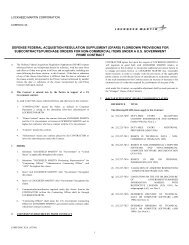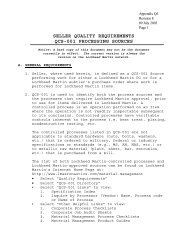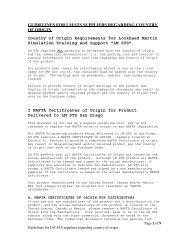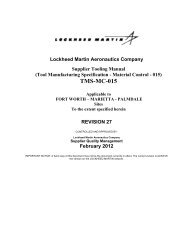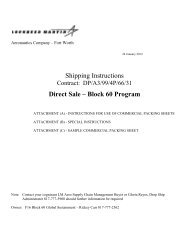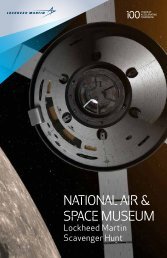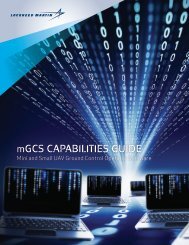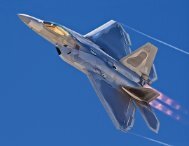VCS-4586 CAPABILITIES GUIDE - Lockheed Martin
VCS-4586 CAPABILITIES GUIDE - Lockheed Martin
VCS-4586 CAPABILITIES GUIDE - Lockheed Martin
You also want an ePaper? Increase the reach of your titles
YUMPU automatically turns print PDFs into web optimized ePapers that Google loves.
<strong>VCS</strong>-<strong>4586</strong> <strong>CAPABILITIES</strong> <strong>GUIDE</strong>Ground Control Operator Software for Unmanned Vehicle Systems
Operator Software for Unmanned Vehicle SystemsDiscover <strong>VCS</strong>-<strong>4586</strong><strong>VCS</strong>-<strong>4586</strong> is an integrated command, control and information ground control software applicationdesigned for controlling and monitoring unmanned vehicles. It is the world’s first commercial off-theshelf(COTS) control station software developed in accordance to STANAG <strong>4586</strong>.<strong>VCS</strong>-<strong>4586</strong> allows operators to simultaneously control multiple integrated vehicles of varying typesfrom a single workstation and common user-interface. Vehicles and their associated sensors can becontrolled and monitored in real-time though the software’s intuitive and user-friendly interface that canreconfigure itself to support the functionality of the vehicles it is controlling.Easy to train and easy to operate, our software has been the platform of choice for unmanned vehiclesystem applications around the world. Our software has been used for over 15 years in ground controlstations to operate unmanned aerial vehicles (UAV), unmanned ground vehicles, air/sea target dronesand loitering munitions. It is a suitable ground control solution for all unmanned vehicle applications fromcivil to military, mini to large. It is considered a robust and proven platform and has been integrated withthe AAI Aerosonde and RQ-7B Shadow, Boeing ScanEagle, Aurora Flight Sciences GoldenEye 80, GeneralAtomics Aeronautical Systems MQ-1C Sky Warrior, Meggitt Training Systems Barracuda, Hammerheadand Vindicator, Northrop Grumman MQ-5B Hunter and many more. Our software is installed in all theU.S. Army’s One System Ground Control Station shelters and has accumulated over 1,000,000 hours ofoperational use.Interoperability with STANAG <strong>4586</strong><strong>Lockheed</strong> <strong>Martin</strong> CDL Systems has been an active participant in the development and evolution of theNATO interoperability standard for unmanned vehicles: STANAG <strong>4586</strong>. This standard establishes acommon control protocol to promote UAV interoperability. It is regarded to be an effective standard formilitary and emerging commercial unmanned vehicle applications.In the STANAG <strong>4586</strong> architecture, <strong>VCS</strong>-<strong>4586</strong> ground stations communicate with unmanned vehicles andtheir payloads through the Vehicle Specific Module (VSM), a component designed and integrated by ourcustomers to translate the STANAG <strong>4586</strong> protocol to the vehicle’s native protocol and to encapsulatevehicle specific functioanlity. <strong>VCS</strong>-<strong>4586</strong> can assume control of vehicles connected to a STANAG <strong>4586</strong>compatible VSM or communicate directly with vehicles that natively support the STANAG <strong>4586</strong> protocol.This enables the interoperability of unmanned vehicles and their sensors, irrespective of type, using acommon operator interface.1
<strong>VCS</strong>-<strong>4586</strong>Capabilities & FeaturesIntegrated Real-Time VideoUnmanned vehicles are primarily used for remote sensing applications. Access to real-time video from anElectro-Optic/Infrared (EO/IR) sensor is crucial to ensuring that mission objectives are consistently andeffectively met. <strong>VCS</strong>-<strong>4586</strong> includes an integrated video suite featuring:• Support for analog video (NTSC, PAL)• Support for digital video (MPEG-2 and H.264 with KLVmetadata (MISB 0601.2), as defined in STANAG 4609)• Software-based decoding for digital videoeliminating the need for a dedicated video card• Export of video and metadata to external C4I nodes(e.g. remote video terminal (RVT) applications)• Configurable textual and graphical overlaysindicating vehicle location and heading, sensorbearing and elevation, height above target and slantrange and numerous other parametersLive sensor and video data can be manipulated using built-in features that give the operator the ability to:• Specify sensor stare-point by clicking on video display or map• Toggle between EO, IR and EO/IR fused modes• Dynamically control sensor zoom• Operate sensor using a joystick• Capture and save still video frames as images (JPG, TIFF, lossless NITF2.1 with metadata)• Pause video and associated metadata in real-time• Measure geographical distance and bearing between any two points on video display• Use hotkeys to access commonly used functions• Adjust video brightness, contrast, hue and saturation for viewingIn order to readily interface with a variety of sensor platforms, <strong>VCS</strong>-<strong>4586</strong> supports several commonsensor operation modes:• Inertial (stare-point remains at a fixed coordinate and can be manually slewed)• Point-at-Coordinates (stare-point remains fixed at designated coordinate)• Heading hold (stare-point remains at a fixed heading and can be manually slewed)• Autotrack (stare-point tracks the image at the center of sensor field of view)• Rectangular- and strip-based wide area search patterns2
Interactive Map for Enhanced Situational AwarenessMap-centric functionality.Situational awareness is key in ensuring mission effectiveness and operational safety. Aninteractive map serves as the primary situational awareness component of <strong>VCS</strong>-<strong>4586</strong>. It providesreal-time geo-referenced position and direction information of all operational componentsincluding vehicles, sensors and data links. By clicking directly on the map, the operator can:• Assume system-wide control of a vehicle/sensor in a multiple vehicle/sensor operation• Specify a heading or loiter point for a vehicle• Specify a stare-point location for an EO/IRsensor• Define and modify mission waypoints• Capture and save screenshot of map (JPG,BMP, PNG, XPM, NITF2.1 with metadata)• Adjust map zoom from 13% to 800%Design based on commonly used standards.Every application and mission is unique. To accommodate a wide range of common standards andoperator preferences, the map supports:• Latitude and longitude (DMS, DMM), MGRS and UTM coordinate systems• Over 30 commonly used geodetic datums (WGS84, NAD27, etc.)• Digital Terrain Elevation Data (DTED) Level 0, Level 1, Level 2• Import of National Geospatial-Intelligence Agency (NGA) raster formats (ADRG, CADRG, CIB)• Common Operating Picture (COP)• MIL-STD-2525B symbols and tactical graphics• Importing of scanned maps, digital maps, satellite imagery, and other geo-referencedimageryManage targets, restriction zones and points of interest with object layers.The various dynamic entities that appear on the map are organized into object layers. Object layersare used to facilitate and enhance situational awareness by showing the operator informationnecessary for the mission. <strong>VCS</strong>-<strong>4586</strong> allows a high level of interaction with the various objectsappearing on the map enabling operators to:• Designate and manage lists of targets and points of interest• Use the MIL-STD-2525B symbol set to designate hostile, friendly, neutral and unknowntargets• Command an EO/IR or Synthetic Aperture Radar (SAR) sensor to monitor a designatedtarget or point of interest• Send a Tactical Communication (TACCOM) message with target information throughC4I infrastructure• Specify multi-sided “no-fly” and “no-look” zones• Interface with external third-party applications through the API to display customizedoverlays on map• De-clutter map by specifying which layers or information to hide3
Mission Planning and ManagementA comprehensive mission editor.<strong>VCS</strong>-<strong>4586</strong> allows operators to automate certain vehicle and sensor tasks, thereby allowing themto focus on mission objectives. The following types of missions can be automated:• Flight routes (specified as a series of waypoints for vehicleto travel across)• Contingency routes (specified action to be taken in theevent of link-loss or other emergency)• Search patterns (specified zone of interest to besystematically searched by sensor)Mission editor features include:• Real-time creation and modification of flight/contingencyroutes and search patterns• Point-and-click selection of mission waypoints on map• Manual entry of location coordinates, altitude and speedparameters of mission waypoints• A 2-D terrain display to illustrate the position of routemission waypoints relative to terrain profile• Mission validation to indicate terrain violations, airspaceconstraints and data link coverage outagesVehicle management<strong>VCS</strong>-<strong>4586</strong> specializes in multiple vehicle control and allowing operators to effectively managesensor platforms and focus on mission tasks. To facilitate this, <strong>VCS</strong>-<strong>4586</strong> features a high levelof autonomous vehicle control. Using the point-and-click user interface, operators can sendmission, loiter and other control commands to integrated vehicles with the software determiningand executing the optimal course of action. These actions are executed in a manner that keep thevehicles within their respective operational envelopes. The user-interface is engineered basedon human factors considerations that keep the operator fully aware of commanded intentionsand vehicle status.Built-in flight modes.A number of automatic flight modes commonly used by UAVs areavailable to the operator:• Points Navigation (configurable loiter pattern: circular,racetrack, hover, figure-8)• Mission (vehicle flies pre-planned mission route)• Camera Guide (loiter point determined by sensorstare-point location)• Launch (initiates vehicle specific launch sequence)• Autoland (initiates vehicle specific automatic landingsequence)• Waveoff (initiates vehicle specific behavior in theevent of an aborted landing)4
Vehicle specific configurability.<strong>VCS</strong>-<strong>4586</strong> can dynamically update its user-interface based on STANAG <strong>4586</strong> configurationmessages as the operator switches between different vehicles and sensors. Componentssuch as digital readouts and instrumentation specific to those vehicles and sensors appear onthe user-interface while unnecessary components are hidden from view. This vehicle specificconfigurability keeps the interface de-cluttered, organized and relevant, thereby increasing theoperator’s overall effectiveness.Data link management.<strong>VCS</strong>-<strong>4586</strong> supports omni, line-of-sight (e.g. Tactical Common Data Link (TCDL)) and satellitedata links. It allows operators to configure, control and monitor ground data terminals (GDT) andairborne data terminals (ADT) by enabling them to:• Set up data link parameters by initializing and managing data link frequencies, rates andencryption codes• Auto-align data link pedestal antenna azimuth and elevation• Use built-in auto-tracking algorithms to automatically track vehicles by adjusting antennaazimuth and elevation• Determine optimal data link location in operational areaOperational SafetyOperator awareness is crucial in operating multiple vehicles and sensor platforms efficientlyand safely to effectively achieve mission objectives. <strong>VCS</strong>-<strong>4586</strong> is the product of extensivehuman factors research and every facet of the software is engineered with a strong focuson operational safety and considerations that enhance operator awareness. The software isdesigned to keep the operator informed of the overall systemstatus and to provide indications of abnormalities in real-time.Some design features include:• Consistent software-wide color scheme to clearlydistinguish downlink and uplink parameters• High level of autonomous vehicle and sensor control• Automatic safety features (e.g. automatic minimumaltitude clearance)• Popup warning, caution and advisory (WCA) messaging system• Color-coded WCA messages to indicate level of severity• Intelligent synchronization on vehicle takeover• Support for audible alerts and messages• Over 75 built-in messages originating from 14 subsystems• An API for easily adding customized WCA messages5
Deployment and IntegrationNetwork-centric functionality.<strong>VCS</strong>-<strong>4586</strong> is designed as a robust network-centric platform highly adapted for connectivity tothird-party applications and C4I infrastructure. Its design enables it to directly connect to vehicles,sensors and data links as network nodes and allows easy integration of external applications throughthe built-in <strong>VCS</strong>-<strong>4586</strong> API.Easy to train, easy to operate.An intuitive point-and-click interface for vehicle and sensor control and high levels of autonomyfor automating operator tasks means that operators don’t need extensive training. Instead,operators are able to focus their attention on mission and sensor management. Operators use asimilar user-interface for all vehicles, eliminating the need for onerous cross-platform training.The built-in simulator application can be used for basic operator training and mission rehearsal.<strong>VCS</strong>-<strong>4586</strong> can be integrated with various synthetic terrain environments offering operators theability to train and rehearse with unprecedented realism. Virtually any synthetic environmentcan be integrated through the <strong>VCS</strong>-<strong>4586</strong> API which gives public access to all internal variables.Some existing integrations include <strong>VCS</strong>-<strong>4586</strong> and:• CAE STRIVE and Medallion S• MetaVR VRSG• Microsoft Flight Simulator X• MultiGen-Paradigm Vega Prime• Multiple Unified Simulation Environment (MUSE)• Simlat ST-1Versatile system integration.<strong>VCS</strong>-<strong>4586</strong> is a commercial off-the-shelf (COTS) software solution. Whether it’s run on a stateof-the-artLinux platform with two high-resolution monitors or a stripped down ruggedizedlaptop with a low-resolution display, the software is engineered to work. The <strong>VCS</strong>-<strong>4586</strong> userinterfaceis designed to make effective use of screen real estate and to take advantage ofLinux, Solaris and Windows operating systems. This hardware flexibility affords a high level ofcustomizability in the ground control station design and setup.6
Canada/International Sales+1.403.289.1733U.S./Latin America Sales+1.256.704.1370<strong>Lockheed</strong> <strong>Martin</strong>Mission Systems and Training300 M Street, SEWashington, DC 20003www.lockheedmartin.com/mst/product_contactsCopyright ©2013 <strong>Lockheed</strong> <strong>Martin</strong> CorporationAll rights reservedPIRA# OWG201307003<strong>Lockheed</strong> <strong>Martin</strong> CDL Systems,a Division of LM Canada, Inc.Harvest Hills Office ParkBldg 5000, #5301, 333-96 Avenue NECalgary, Alberta, Canada T3K 0S3P: +1.403.289.1733F: +1.403.289.3967<strong>Lockheed</strong> <strong>Martin</strong> CDL SystemsUSA, Inc.Perimeter Corporate Park1525 Perimeter Parkway, Suite-520Huntsville, Alabama, USA 35806P: +1.256.704.1370F: +1.256.704.1390




